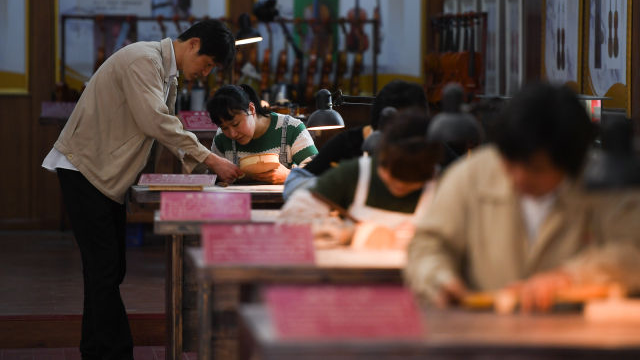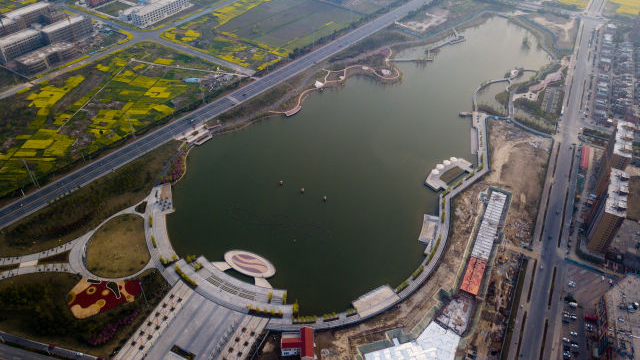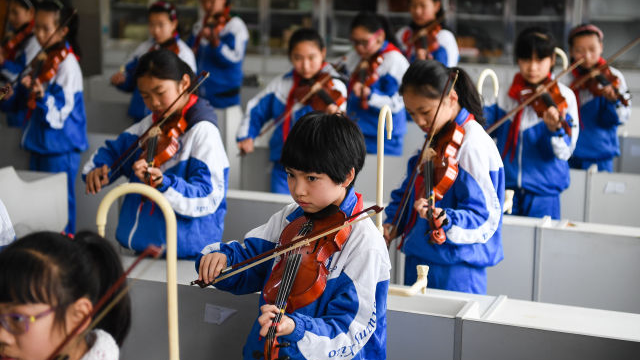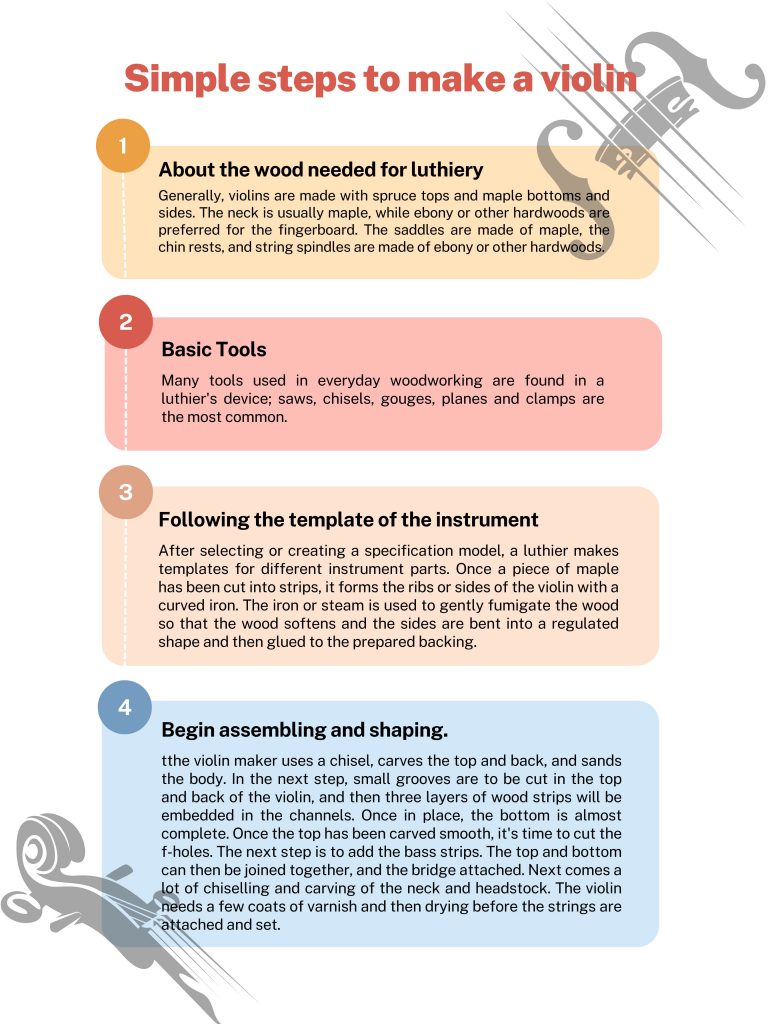Huangqiao is the capital of China’s violin industry and the world’s most extensive violin production base. How do Chinese workers who don’t know much about Western classical music produce 30% of the world’s violins?
The table is piled with wood chips, thimbles, planes, carving knives and other coloured tools scattered on the workbench. Young luthier Xiaofeng Xu puts his ear against the freshly polished board and taps it a few times.
It’s a “conversation” with the wood, “It’s a good material, but it’s not ready yet,” Different woods require different production techniques and can have very different tones. Xiaofeng caresses the maple block with love in his eyes.
In the spring of 1993, Xiaofeng heard the violin for the first time when a performance team arrived in Huangqiao, Taizhou, Jiangsu Province. Later, he became a violin maker. “When I first started, I studied the preparatory work of sharpening knives and breaking materials for most of the year and practised until I couldn’t even hold the bowls and chopsticks.” Xiaofeng stretches out his hands, and the years of hard work have left his fingertips and the backs of his hands covered with calluses.

A violin comprises more than 70 parts, and each step of the production process affects the upper limit of the violin’s tone. The process is very complex, but Xiaofeng operates in an orderly manner. To ensure the quality of the violin, the parts are polished to the millimetre. “All I have to do is to keep pursuing perfection.” With the spirit of craftsmanship, he strives for excellence and perfection on the way to making a violin.
A good luthier can create a violin with personality according to the requirements and playing habits of the player. There are no two identical handmade violins in the world, and the unique skills and aesthetics of the maker are reflected in everything from the choice of materials and accessories to the craft’s design. Today, Xiaofeng is known as a famous violin maker in his hometown, and some people admire the nightingale sound of his violins.
He thinks the benchmark for good instruments is much more than the price. With over ten years of experience, he has built a reputation in the industry. He has won many prizes in violin-making competitions. Xiaofeng shows off his violins, with their delicate curves, curved corners, and exquisitely oiled bodies, lacquered like translucent ambers, like an elegant work of art.
He would have earned a pretty good income if he had gone to a big city to open a workshop. But he chose to return to Huangqiao, where the industry is completing a generational handover. Xiaofeng decides to set up a studio in the Fengling company and bring a group of young people to carry on the work of the elders.
“Hearing musicians playing beautiful melodies on the violins I make is what I am most proud of,” Xiaofeng said.
Sixty years ago, Huangqiao was a town that only supplied parts to instrument factories in Shanghai. Today, it is a place where luthiers and companies are created and where apprentices, small businesses and stories are born.
Walking into Huangqiao, you can get a glimpse of the economic transformation of this Chinese town. When the farmers tried to shape some wood, no one could have imagined that it would be sold worldwide.
In 1962, two workers from the Shanghai violin factory returned to Huangqiao, and some villagers began to learn how to sharpen the violin head, the most basic of all violin-making techniques. A violin head was worth 50 cents, and for a poor town, this little extra income meant an excellent dinner for a family.
After ten years, the Huangqiao Musical Instrument Factory was set up to supply Shanghai with violin heads, bows and other accessories. The following year, a young man called Shu Li came to work as an apprentice. He worked hard and became a skilled worker in just two months.
When Shu Li took over as factory manager, the factory was in a bad situation and owed 540,000 yuan to the bank. He couldn’t even pay for the bus to Shanghai because there was no money in the account to cover his business trip.
Shu Li turned to the Shanghai Violin Factory to get a chance to make complete violins instead of accessories. He counted all the steps of violin making, materials and salaries. He told the factory’s staff, “I can make a violin for one-third of your cost”.
He had never made a whole violin before. Still, Shu Li believed that if there was a way out, the Huangqiao people were willing to learn the techniques.
The Shanghai Violin Factory was impressed by their sincerity. In 1985, Huangqiao officially became a branch of Shanghai’s Factory and signed a 10-year contract.

There was a big market out there at that time, and the factory’s sales revenue reached almost 300,000 dollars, with profits of more than 45,000 dollars. When it came time to recruit workers, many local farmers actively rushed to apply.
As far as the manufacturing process is concerned, the violin is a very complex instrument. Shu Li often noticed staff working diligently to plan boards, cut edges, glue, and paint during the cooperation with Shanghai. “They were constantly learning the craft even after work,” said he.
In 1995, this little factory independently made more than 60,000 violins, making them the top in this country. With the tide of marketization, Huangqiao’s business gradually gathered to the foreign market.
In 1992, Shu Li went to Frankfurt to attend the International Musical Instrument Trade Fair. He brought his factory-made violin, but he didn’t show it. He exclaimed: “How come foreign manufacturers make such good instruments!” He bought a few German-made instruments and brought them back to show the factory staff so people could learn from them.
When he attended the exhibition again, Shuli took his own factory’s instruments, and he offered only $15. Huangqiao violins impressed instrument dealers all over the world this time.
In 1995, the American AXL musical instrument company participated in the Instrument trade fair. Ninety-five samples must be produced, which generally took three months of work. Still, Huangqiao’s people worked overtime and completed the order in 53 days. AXL took the initiative to set up Fengling Musical Instrument Co., Ltd. with Huangqiao Town.
The Sino-foreign cooperation opened sales channels. Half of Fengling’s production was sold to Europe and the USA through AXL, and the internationally famous industry standards were brought to Fengling through AXL. As a result, Fengling became the “Whampoa Military School” of the Huangqiao instrument industry, enabling a group of farmers to escape poverty and become rich.
At the peak of its production scale, Fengling had more than 1,000 employees and produced more than 300,000 violins a year. More than 60 managers of violin factories in Huangqiao came from Fengling. The town’s production accounted for 70% of the total domestic output.
While Huangqiao is busy developing overseas markets, Europe is also gradually opening the Chinese market. The difference was that China sold cheap violins for beginners. In contrast, others sold expensive violins for over ten thousand dollars for professionals.
Jianxin Wu, who runs a musical instrument factory, believes a violin for professionals is like artwork with a high price and a small quantity. In contrast, a violin for beginners is a commodity with a small profit but a large quantity. “It is not a shame to produce cheap violins. They satisfy the needs of many children who are just starting to learn to play,” said he.
Huangqiao’s oldest luthier, Bojian Lu, is 82 years old. A concertmaster of a foreign orchestra bought one of his most expensive instruments two years ago. The violin was made 40 years ago and sold for over $20,000.
Although not every one of them fetches such a high price, the average cost of his instruments is above $1,500. It is hard to imagine that this older man was a countryside carpenter.
Bojian’s sons and grandson also inherited his craft. Two generations, father and son, have dedicated their lives to violin making.
Lu Guanbao’s hair is grey, he is dressed in work clothes, and he talks with a glowing voice and sparkling eyes. His studio is hung with finely string instruments. “Violin making is the business and products for us, but the culture and artwork for Italians. Culture will slowly settle down in time. There is no need to rush,” said Guanbao Lu, son of Bojian.
A good violin has a light, tense sound and a complete and broad tone. It is the work of a great violin maker who combines material science, mechanics, acoustics, and even mathematics and aesthetics with the polish of time. a Stradivarius violin will be worth millions of dollars. This price is still unreachable for Huangqiao or even for Chinese luthiers.
He believes there is no gap between the Chinese and Italian luthiers regarding skill. The difference is that the industrial upgrading will rely on cultural immersion, and the Chinese need to strengthen their understanding of materials, nature, and beauty.

Guanbao used to go to concerts with family in the surrounding cities on weekends. After discovering his daughter’s musical talent, he often took her on trips to Shanghai and Nanjing to have lessons from famous cello teachers. “Huangqiao must be able to make both good instruments but also good composers and performers, and then we can make a significant music town.”
A few years ago, Huangqiao started popularising musical instrument education among young kids. Mr Bo Yin, a violin teacher for many years, was hired at the local primary school.
“Teaching violin in large classes is difficult; the children can’t play in tune for six months, and at first, it’s not even easy to maintain discipline,” said Yin Bo. For this reason, they hold weekly meetings with parents to teach tuning. For the first time, many factory workers heard the sound of a violin playing at home. They have organized a 60-member string orchestra in a rural primary school.
Huangqiao is trying to become a philharmonic town. In some restaurants, the lobby manager and servers can have a small ensemble if they change their clothes. People can pick up a violin on the streets and show off their skills. Guanbao said: “I hope that in the future musical instruments will be as normal as furniture, so more and more Chinese from ordinary families will have the chance to enjoy music.”

